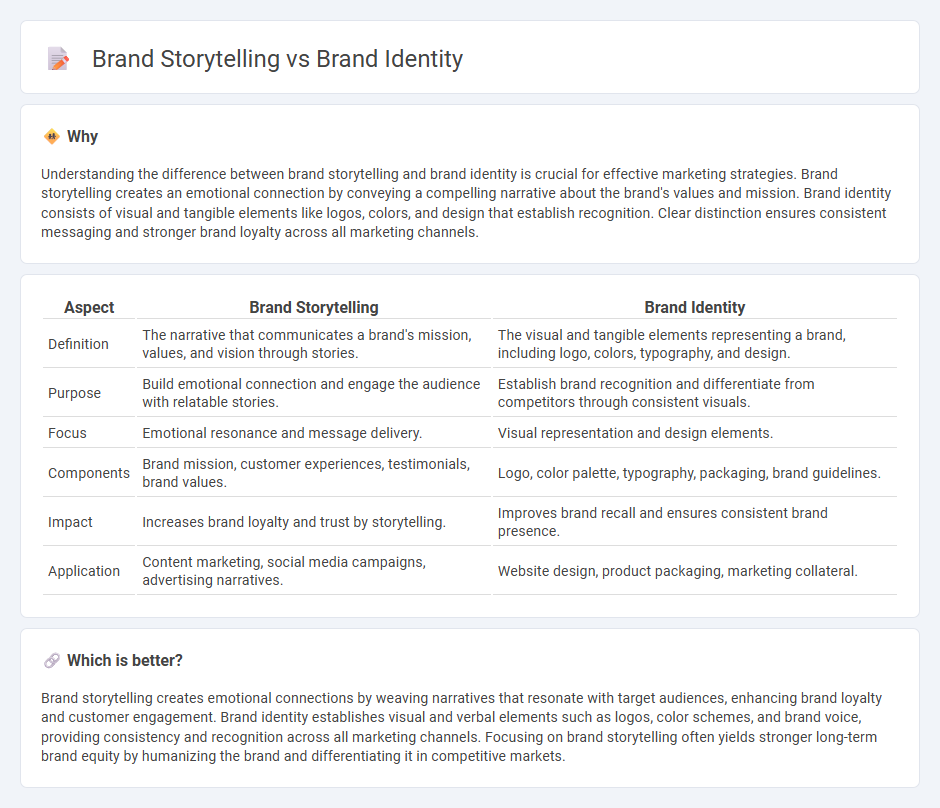
Brand storytelling crafts compelling narratives that connect emotionally with audiences, while brand identity defines the visual and verbal elements that distinguish a brand in the market. Effective storytelling enhances brand perception by conveying values and mission through relatable stories, whereas brand identity ensures consistency across logos, colors, and messaging. Explore how integrating both strategies can strengthen your marketing impact.
Why it is important
Understanding the difference between brand storytelling and brand identity is crucial for effective marketing strategies. Brand storytelling creates an emotional connection by conveying a compelling narrative about the brand's values and mission. Brand identity consists of visual and tangible elements like logos, colors, and design that establish recognition. Clear distinction ensures consistent messaging and stronger brand loyalty across all marketing channels.
Comparison Table
| Aspect | Brand Storytelling | Brand Identity |
|---|---|---|
| Definition | The narrative that communicates a brand's mission, values, and vision through stories. | The visual and tangible elements representing a brand, including logo, colors, typography, and design. |
| Purpose | Build emotional connection and engage the audience with relatable stories. | Establish brand recognition and differentiate from competitors through consistent visuals. |
| Focus | Emotional resonance and message delivery. | Visual representation and design elements. |
| Components | Brand mission, customer experiences, testimonials, brand values. | Logo, color palette, typography, packaging, brand guidelines. |
| Impact | Increases brand loyalty and trust by storytelling. | Improves brand recall and ensures consistent brand presence. |
| Application | Content marketing, social media campaigns, advertising narratives. | Website design, product packaging, marketing collateral. |
Which is better?
Brand storytelling creates emotional connections by weaving narratives that resonate with target audiences, enhancing brand loyalty and customer engagement. Brand identity establishes visual and verbal elements such as logos, color schemes, and brand voice, providing consistency and recognition across all marketing channels. Focusing on brand storytelling often yields stronger long-term brand equity by humanizing the brand and differentiating it in competitive markets.
Connection
Brand storytelling and brand identity are intrinsically connected through the consistent communication of core values, mission, and vision that shape customer perception. Effective brand storytelling enhances brand identity by creating emotional engagement and authentic narratives that reinforce the brand's unique personality and promise. This synergy drives brand loyalty, differentiates the business in competitive markets, and increases overall brand equity.
Key Terms
Visual Elements (for Brand Identity)
Brand identity primarily focuses on visual elements such as logo design, color schemes, typography, and packaging to create a consistent and recognizable image for a brand. These components establish the brand's personality and differentiate it from competitors in the marketplace. Explore more about how visual elements power brand identity and shape customer perception.
Narrative (for Brand Storytelling)
Brand identity encompasses the visual elements, values, and personality that define a brand, creating recognition and consistency across platforms. Brand storytelling centers on crafting a compelling narrative that emotionally connects with the audience, conveying the brand's mission, vision, and unique value through authentic, relatable stories. Explore how mastering narrative techniques can elevate your brand storytelling to build deeper customer loyalty and engagement.
Consistency
Brand identity establishes the visual and verbal elements that consistently represent a company's values, mission, and personality, ensuring recognition and trust across all touchpoints. Brand storytelling reinforces this consistency by crafting authentic narratives that align with the established identity, creating emotional connections with the audience. Explore how maintaining consistency between brand identity and storytelling enhances brand loyalty and market presence.
Source and External Links
What Is Brand Identity? | The Branding Journal - Brand identity is the unique set of characteristics that shape a brand's personality and appearance, enabling it to differentiate itself, build emotional connections, and ensure consistent communication for long-term success.
What is brand identity? (and how to build one) - Canva - Brand identity combines visual elements like colors and logos with voice and tone to represent a company's personality, values, and mission, serving as the recognizable face of the brand.
What is Brand Identity? | Professional Academy - Brand identity consists of various elements derived from a company's mission, value proposition, and goals, used to communicate the brand's essence and create a desired brand image.
 dowidth.com
dowidth.com